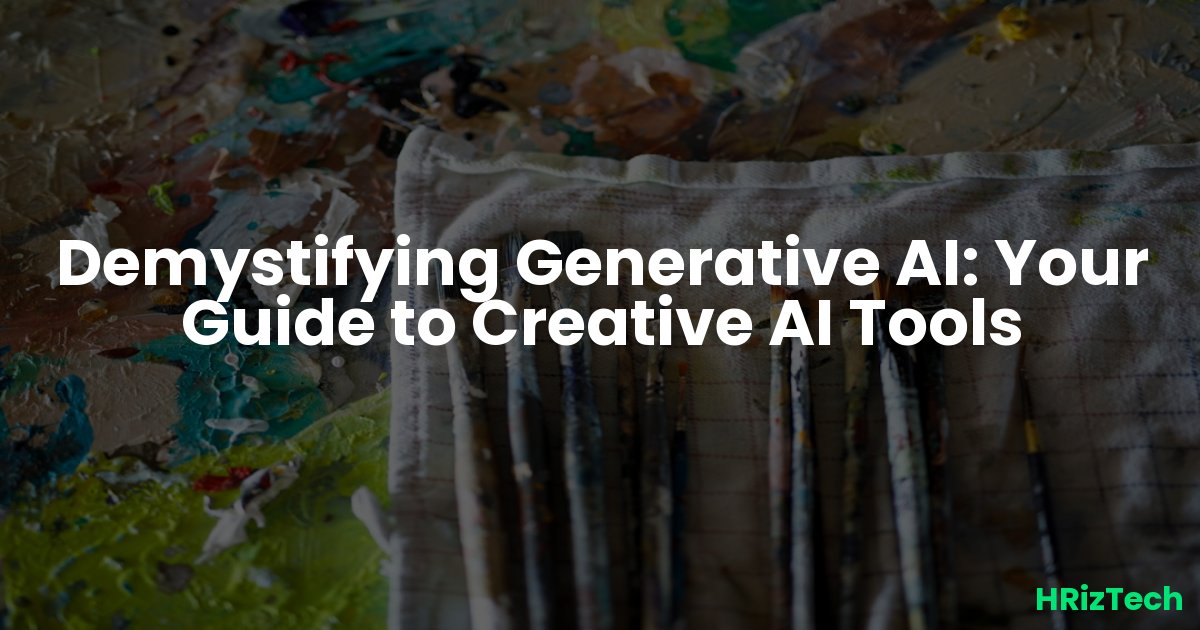Demystifying Generative AI: Your Guide to Creative AI Tools

Demystifying Generative AI: Your Guide to Creative AI Tools
Ever wished you had a personal creative assistant that could whip up marketing copy, write poems, or even compose music? That's the magic of generative AI. It's no longer science fiction; it's a powerful tool transforming how we work and create. But navigating the world of generative AI can feel overwhelming. This post aims to demystify Generative AI, exploring its capabilities and how you can start using it today.
What is Generative AI, Exactly?
Generative AI, a subset of artificial intelligence, uses algorithms to create new content. Unlike traditional AI that analyzes existing data, generative AI actually *generates* new data, such as text, images, audio, and video. Think of it as a sophisticated digital artist, writer, or musician, capable of producing unique outputs based on your prompts and parameters. It's a fundamental shift in how we interact with technology, moving beyond simple data analysis to actual content creation.
How Do I Start Building an AI Chatbot with Generative AI?
Building an AI chatbot using generative AI isn't as daunting as it sounds. Many platforms offer user-friendly interfaces and pre-trained models. The key is choosing the right platform based on your needs and technical skills. Some popular options include Dialogflow (Google Cloud), Amazon Lex, and Rasa. These platforms allow you to define the chatbot's personality, knowledge base, and conversational flow without needing extensive coding expertise.
Step-by-Step Guide to Building a Simple Chatbot:
- Choose a platform: Select a platform that best suits your technical capabilities and project requirements.
- Design the conversation flow: Plan out the different scenarios and user inputs your chatbot should handle.
- Train the model: Feed the platform with data to teach your chatbot how to respond to various queries.
- Test and refine: Test your chatbot thoroughly and make adjustments to improve its performance.
- Deploy and monitor: Once satisfied, deploy your chatbot and continuously monitor its performance.
Generative AI Tools for Various Applications
Generative AI isn't limited to chatbots. Its applications are vast and rapidly expanding. From marketing to design to music composition, the possibilities are endless. Let's explore some examples:
Marketing & Content Creation:
Tools like Jasper and Copy.ai leverage Generative AI to create marketing copy, blog posts, social media content, and more. They significantly streamline content creation, allowing marketers to produce high-quality material efficiently.
Image Generation:
Platforms like Midjourney, Dall-E 2, and Stable Diffusion are revolutionizing image creation. Simply input a text prompt, and these tools generate stunning and unique visuals. This is changing the landscape of graphic design and visual storytelling.
Music Composition:
Generative AI is even making inroads into music composition. Tools are emerging that can compose original music pieces in various styles, assisting musicians and composers in their creative process.
Addressing the Challenges: Ethical Considerations and the Future of Generative AI
While Generative AI offers immense potential, it's crucial to acknowledge the challenges. Ethical concerns surrounding copyright, bias in algorithms, and the potential for misuse need careful consideration. A 2025 Gartner report predicts increased focus on responsible AI development and deployment to mitigate these risks. (Insert Gartner Report Link Here)
Looking ahead to 2025 and beyond, Generative AI is poised for even more significant advancements. We can anticipate more sophisticated models, wider applications across industries, and increased integration with other technologies. Cybersecurity will become even more critical as we rely more heavily on these systems.
Generative AI: Your Competitive Advantage in 2024 and Beyond
Mastering Generative AI can provide a significant competitive advantage. By understanding its capabilities and effectively utilizing the available tools, you can streamline workflows, enhance creativity, and unlock new possibilities in your field. It’s no longer a futuristic concept; it's a technology ready to transform your work today. This makes Generative AI a key tool to explore and understand.
What are your biggest challenges when it comes to implementing Generative AI in your workflow? Have you tried any of the tools mentioned above? Let’s discuss!
What’s your favorite AI tool? Share below!
Comments
No comments yet. Be the first to comment!